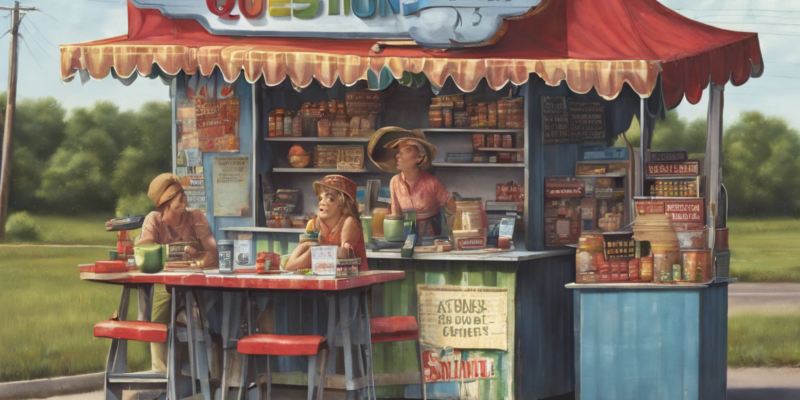Roadside Stand: A Nostalgic American Tradition
Remember the last time you drove down a quaint country road and stumbled upon a charming roadside stand? Maybe it was a patch of fresh strawberries or a set of handmade crafts beckoning you to stop. These charming stands have been a part of America’s landscape for decades, embodying the spirit of entrepreneurship, community, and quality products. In this comprehensive guide, we’ll delve into the world of roadside stands, exploring their history, significance, what you can find there, and how you can start your own.
The History of Roadside Stands
Roadside stands have a rich history deeply rooted in American tradition. Dating back to the early 20th century, these stands were commonly found along rural roads, offering goods grown or crafted by local artisans. The stand owners would display their produce or products on simple tables or shelves, relying on the honesty of customers to leave payment in a designated box or jar.
Over the years, roadside stands have evolved from simple wooden structures to more organized and aesthetically pleasing displays. Despite these changes, the essence of the roadside stand remains the same – a place where consumers can purchase fresh, locally sourced goods while supporting small-scale producers.
Why Roadside Stands Matter
In today’s fast-paced, digital world, roadside stands offer a welcome respite. They provide a connection to the land, to the people who grow our food, and to the communities we live in. By purchasing from a roadside stand, you are supporting local farmers and artisans, reducing your carbon footprint, and enjoying the freshest produce and products available.
What You Can Find at a Roadside Stand
Roadside stands offer a diverse array of products, depending on the season and the location. Some common items you might find include:
- Fresh produce: From juicy tomatoes to crisp apples, roadside stands are known for their farm-fresh fruits and vegetables.
- Homemade goods: Jams, jellies, pickles, and baked treats are popular items at many roadside stands.
- Crafts: Some stands feature handmade crafts such as pottery, jewelry, knitted items, and wooden toys.
- Flowers and plants: Many stands sell beautiful bouquets, potted plants, and fresh-cut flowers.
- Honey and other artisanal products: Roadside stands often carry specialty items like honey, maple syrup, cheese, and handcrafted soaps.
How to Start Your Own Roadside Stand
If you’ve been inspired to start your own roadside stand, here are some steps to get you started:
- Research local regulations: Check with your city or county government to understand any zoning laws or permits required for operating a roadside stand.
- Choose your products: Decide what you want to sell at your stand. Consider your interests, skills, and the demand in your area.
- Create a business plan: Outline your budget, pricing strategy, target market, and marketing plan.
- Set up your stand: Invest in a sturdy table or display, signage, and any necessary equipment for showcasing your products.
- Promote your stand: Use social media, local advertising, and word-of-mouth to attract customers to your stand.
By following these steps and putting in the effort to create a welcoming and attractive roadside stand, you can join the ranks of proud small business owners who bring joy and quality products to their communities.
Frequently Asked Questions (FAQs)
Q1: Are roadside stands only found in rural areas?
A1: While roadside stands are more commonly associated with rural settings, you can also find them in suburban and even urban areas, often at farmers’ markets or community events.
Q2: How do roadside stand owners price their products?
A2: Pricing at roadside stands is typically straightforward and based on factors like the cost of production, market demand, and competition. Many owners use transparent pricing strategies to build trust with customers.
Q3: Can I haggle over prices at a roadside stand?
A3: While haggling is less common at roadside stands than in traditional markets, some owners may be open to negotiating prices, especially towards the end of the day or for larger purchases.
Q4: Are products at roadside stands always organic or locally sourced?
A4: While many roadside stands prioritize offering organic or locally sourced products, not all stands adhere to these standards. It’s always good to ask the stand owner about their farming practices and sourcing.
Q5: Do roadside stands accept credit cards or mobile payments?
A5: Some roadside stands accept credit cards, mobile payments, or digital payment apps, but others may operate on a cash-only basis. It’s best to come prepared with cash, just in case.
Whether you’re a seasoned roadside stand enthusiast or a newcomer eager to explore these charming vendors, there’s something special about the experience of shopping at a stand by the side of the road. Embrace the simplicity, authenticity, and community spirit that roadside stands embody, and enjoy the unique treasures they have to offer.


Comments